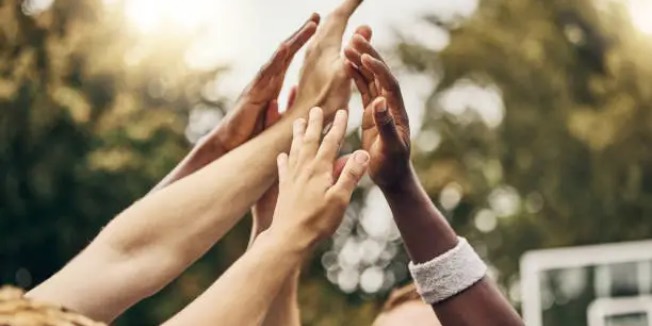How 100,000 migrants are testing New York
Sam Hawley: Hi, I’m Sam Hawley, coming to you from Gadigal Land. This is ABC News Daily. You might associate New York City with Times Square, the Empire State Building and the Statue of Liberty. But if you visit right now, you may also be struck by something quite different. The Big Apple is struggling to house more than 100,000 migrants who’ve arrived in the past year and has even set up tent cities to ease the pressure. Today, New York city reporter for the Wall Street Journal, Erin Ailworth on the thousands of arrivals flocking to the city each week and the politics behind why they keep coming. Erin, let’s start this chat last August when migrants began arriving in New York City. Just paint a picture for me of that.
Erin Ailworth: They’ve been arriving for quite a while now, actually since spring of 2022. And over time, more than 100,000 of these people have have come into New York. You know, the regular shelters are full. And so they’re coming up with these emergency shelter facilities. And it’s just like what you would imagine. You see them going in and out all day. Sometimes you’ll see the buses bringing them in and dropping them off.
Chanting: No hate, no fear. Immigrants are welcome here. No hate. No fear. Immigrants are welcome here.
Sam Hawley: So more than 100,000 migrants, that’s a lot of people arriving in New York City in a really short period of time. Um, and it’s causing some angst, isn’t it, in the community. There are those who really support them being there, but then there are others that are worried by what’s happening.
New York resident: They don’t belong here. And I’m out here to protest that, you know, I don’t want them out here. We don’t want them out here. They’re not good for this neighbourhood.
Sam Hawley: And the New York mayor, Eric Adams, he says the city is full. It’s at capacity.
Eric Adams, New York Mayor: I don’t see an ending to this. This issue will destroy New York City. Destroy New York City. We get in 10,000 migrants a month. One time we were just in Venezuela. Now we’re in Ecuador. Now we get Russian speaking coming through Mexico. Now we’re getting Western Africa. Now we’re getting people from all over the globe have made their minds up that they’re going to come through the southern part of the border and come into New York City.
Sam Hawley: So, Erin, who are these migrants and what are they saying about their experiences?
Erin Ailworth: They’re coming from countries like Venezuela.
Female migrant: New York has opened up to many people, good people, bad people. I’m one of the good people. The good people are more how I always say ‘you have to work and come out ahead whatever it takes’.
Male migrant: We need you to hear us. We need to work and we need our work permits. Today we’re here representing all Latinos and all migrants, rise high!
Erin Ailworth: Also increasingly West Africa. I was at another shelter in Queens a few days ago, and I spoke to a gentleman and he was from Senegal. And he basically told me that he was hoping to learn English and get to a point where he could get work authorisation. And as he said, he cut hair in Senegal and he’d like to find a job doing that.
Sam Hawley: And some of the children of these migrants, they’re actually beginning to start school in the new school year. Natasha Quiroga She’s one of the people helping the families to adjust and she’s just pointed out there’s a huge amount of challenges that come with this.
Natasha Quiroga, InsideSchools: I think any city would struggle to receive the large number of children that are coming at one time who are also learning English, as well as living in temporary housing, temporary shelters.
Sam Hawley: One of the I guess, extraordinary things about this is that the first migrants that came to New York back in 2022, they were actually sent there, Erin, weren’t they, by the governor of Texas? What was that about?
Erin Ailworth: I think that there were a few waves coming before that. But, yes, this really started to ramp up when Greg Abbott began bussing people from Texas to New York.
Greg Abbott, Texas Governor: When you have an administration that has abandoned, any pretence of securing the border and securing our sovereignty. You see the onrush of people like what we saw…
Erin Ailworth: And essentially arguing, hey, we as border states have dealt with this kind of influx for a really long time. Other states need to help. And so that’s when you started to see these larger numbers coming in. And so in New York City right now, you’re seeing over 2000 a week.
Sam Hawley: Let’s just unpack this a little bit more, because this is part of a Republican campaign in Texas to denounce Democratic border policies. That’s why the Texas governor, Greg Abbott, is sending these migrants to New York City.
Erin Ailworth: Listen, immigration is a hot button issue here, right? You see a large number of people coming through the border. And these border states are arguing again that they’ve dealt with this for a long time. And so it’s time for other states to share some of that burden. That said, New York officials would argue, particularly Eric Adams, that that, you know, the burden that’s being placed on New York City right now is untenable.
Eric Adams, New York Mayor: We are going to never reach the point where we’re going to do what those governors did. Just using migrants as political pawns. We’re never going to do that. And we are at the breaking point.
Sam Hawley: The Republican states in the South are making a statement that you can claim to be compassionate to migrants, but it’s very different when it’s your own problem. And and it really is, isn’t it, Erin, coming at a cost for New York?
Erin Ailworth: Yeah, The mayor has actually estimated that it’s going to cost New York City something like $12 billion by fiscal year 2025.
Eric Adams, New York Mayor: If we don’t get the support we need. New Yorkers could be left for a $12 billion bill.
Erin Ailworth: A lot of it is about finding space, right? But it’s not just about finding space. It’s also about do we have the people to staff that space? You know, are these spaces in safe places? Do we have the school infrastructure and the other community infrastructure to absorb this large of an influx of people?
Sam Hawley: Yeah. And I see reports they’re even thinking of erecting tents in Central Park.
Erin Ailworth: There are not tents in Central Park yet, but there are tents in parks. Randall’s Island. It’s this island between the Harlem and East Rivers, and it’s got dozens of athletic fields. And people go there to, you know, play soccer and jog and picnic with their families. That’s where one of these big tent complex shelters has been set up. Some are getting beds in and space in a traditional shelter space. But but that space is at a premium now. And then other people are being put up in hotels. The city has been trying to prioritise those spaces for families. There is a legal obligation in New York City to shelter people in need. But because space is at that premium, the mayor has instituted a 60 day limit on shelter stays. And so people are being given notice that they’ve got 60 days to try and figure stuff out.
Sam Hawley: So, Erin, how has the Biden administration responded to this influx of migrants to New York?
Erin Ailworth: So there has been some money promised. It’s been slow to arrive. And outside of that, there hasn’t been too much action. Both Eric Adams and Kathy Hochul have been pressing the administration, particularly on work authorisation and, you know, making it easier, essentially, for these people to get authorisation to find a job and work legally.
Kathy Hochul, New York Governor: This crisis originated with the federal government, and it must be resolved through the federal government. The borders and decisions about who can work are solely determined by the federal government.
Erin Ailworth: Part of what’s keeping people in these shelters is that they haven’t been able to find a way to support themselves here, you know, at least not on the books. But there hasn’t been much traction to that conversation. A lot of people say it’s a non-starter.
Sam Hawley: Right, Because New York City at the moment, it is facing a labour shortage, isn’t it? So actually, some more workers are needed.
Kathy Hochul, New York Governor: For me, the answer to these two crises, this humanitarian crisis and our workforce crisis is so crystal clear and common sense. Let them get the work authorisations. Let them work legally. Let them work.
Sam Hawley: These sort of labour shortages came about post pandemic and something like 40,000 home health aides are needed, 70,000 nurses and nursing assistants. So there’s a big problem there.
Erin Ailworth: This is exactly what a lot of people are arguing. If we could get them work authorisation. There are jobs out there, but work authorisation is a process. I mean, you know, putting in an asylum seeker application is a process and one that can take quite a while. And so there’s you know, there are all of this there’s all of this legal red tape.
Sam Hawley: Even though it’s obviously a challenging time, Erin. New York, it’s a migrant city, right? It prides itself on its openness to immigration. It has a really long history of doing that.
Erin Ailworth: A lot of officials bring this up constantly that it is a city of immigrants, and that is the foundation of New York.
Eric Adams, New York Mayor: For centuries, immigrants have made that remarkable journey, that leap of faith, searching for freedom, safety, a shot at the American dream, and the asylum seekers who have arrived in our cities since last spring are writing a new chapter in this timeless story.
Erin Ailworth: And so I think a lot of people here do feel a moral responsibility to help. And when you see pushback, a lot of the times it’s around that logistical question, can we actually handle this influx? Can we afford it? I think I can safely say that there’s not going to be a quick fix to this problem.
Sam Hawley: Erin Ailworth is the New York City reporter for The Wall Street Journal. The New York governor, Kathy Hochul, says the New York state is considering ways to issue work permits to migrants to circumvent a long wait for permits at a federal level. An estimated 59,000 migrants are still in city shelters. This episode was produced by Laura Corrigan, Bridget Fitzgerald, Nell Whitehead and Anna John, who also did the mix. Our supervising producer is David Coady. To get in touch with the team, please email us on [email protected]. Thanks for listening.



